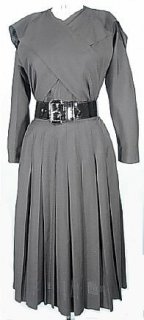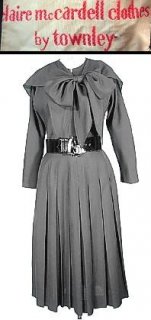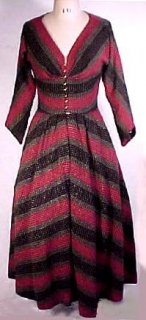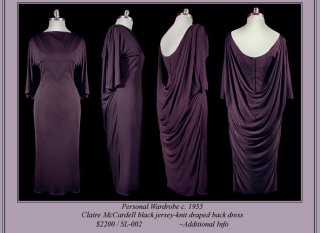purpleviolets
Member
- Joined
- Jan 17, 2006
- Messages
- 196
- Reaction score
- 0
I couldn't find a thread about her so I decided to start one myself. She was a major influence on American style especially sportswear.
CLAIRE McCARDELL
 Claire McCardell has been called the first truly American designer, originator of the "American Look". American women have always admired her for her freshness and energy.
Claire McCardell has been called the first truly American designer, originator of the "American Look". American women have always admired her for her freshness and energy.
1905 Claire McCardell was born in Frederick, Maryland, USA, to a bank-president father. She had 3 younger brothers and grew up with a love of sports.
1925 After high school and two years college, Claire joined fashion illustration at Parsons School of Design (which was then called the New York School of Fine and Applied Arts).
1926 She spent her second year in Paris, at the Parsons branch on Place des Vosges. There she began to blossom, for fashion was all around her. She began to understand the relationship between style and comfort (or rather the lack of it). She returned to New York for her last year at Parsons.
1927 After graduating, she embarked on a frustrating succession of jobs. In 1930 she became an assistant to Robert Turk, a young designer just starting out, His venture failed and so he and Claire afterwards moved to Townley Frocks, an established sportswear house.
 In 1932 Turk died in a sailing accident, so Claire took his position and finished the collection. She stayed with Townley Frocks for 7 years until the company disintegrated.
In 1932 Turk died in a sailing accident, so Claire took his position and finished the collection. She stayed with Townley Frocks for 7 years until the company disintegrated.
1938 While at Townley, she scored her first commercial success, the so called "Monastic Dress", a flowing robe-like design that the wearer shaped to her own waistline with a sash or belt. Best and Co., bought 100 of these dresses and they were soon well-known. In 1939 when Townley folded, she spent a brief time working for Hattie Carnegie, whose house sold Parisian designs. However McCardell's designs were far too simple for Carnegie's tastes.
In 1940 Townley reopened, so Claire McCardell brought out her first collection for them, featuring the then radical natural shoulder, cut in one piece with the sleeve. Rather than copy men's tailoring, as was the fashion, she chose to use pleating or bias cut to achieve a comfortable and appealing fit. She was influenced by Chanel, and Vionnet, and liked buttons that button and sashes that tie.
 1942 This year saw one of her most popular designs the "pop-over" dress, a wrap-around housedress.
1942 This year saw one of her most popular designs the "pop-over" dress, a wrap-around housedress.
During the 40's, Claire McCardell designed a range of beachwear and playsuits which the women of America took to heart. They had never worn such comfortable and attractive casual wear for the beach, or at leasure in their homes. This playsuit is a cotton knit from 1946.
Claire McCardell was very interested in the draping and styling of classical Greece and Rome. Even though she made lots of casual outfits, some of her gowns are really classical in design.
 Here on the right is a pleated nylon chiffon dress from 1950 which was loaned from the collection of F.I.T. New York to the exhibition "Goddess" held by the Metropolitan Museum in Autumn 2003.
Here on the right is a pleated nylon chiffon dress from 1950 which was loaned from the collection of F.I.T. New York to the exhibition "Goddess" held by the Metropolitan Museum in Autumn 2003.
In 1953 Claire married Irving Drought Harris, an architect from Texas. They enjoyed their time together at the farmhouse in Frenchtown, New Jersey.
McCardell was honoured with the prestigious American Designers Coty Award in 1943 and again in 1956.
During 1941-1945 America was isolated from Europe by World War II. This gave American designers such as McCardell, the opportunity to create an "American Look", easy and comfortable. Her inspiration was always America, it's freedom, it's casualness, it's good health. She said "Clothes can say all that".
In 1952 McCardell became a Partner and Vice-President in Townley.
In 1955, Claire used the designs of modern artists like Chagall, Leger, Picasso, Miro and Dufy, to make cotton resort clothes. She then took them to the studios of the artists, in Europe, and the resulting photographs appeared in a spread in LIFE magazine of November 1955. They are shown hereunder:




Top left Marc Chagall print, top right with Fernand Leger, bottom left Picasso print, and right with Joan Miro.
In 1958 Claire McCardell died of Cancer at the age of 53 and the fashion world lost one of it's great designers.
THE McCARDELL STYLE
 McCardell worked by choosing a fabric, stretching it, playing with it, putting it away till inspiration struck. Then she would take it out again, make a little stick drawing and give fabric and drawing for execution. Unlike most other designers, she kept favourite shapes and pieces in her collections, offering them in slight changed form over and over again.
McCardell worked by choosing a fabric, stretching it, playing with it, putting it away till inspiration struck. Then she would take it out again, make a little stick drawing and give fabric and drawing for execution. Unlike most other designers, she kept favourite shapes and pieces in her collections, offering them in slight changed form over and over again.
She designed for American women, busy women, not the formal rich. Mass produced, her clothes were affordable and comfortable. She forbade her models to wear rigid underclothes and made her designs so that they could be adjusted to any shape by drawstring necklines, or sashes or belts.
She used casual fabrics, like denim, sailcloth, balloon cloth, corduroy, wool jersey, lingerie nylon, wool fleece, seersucker, calico and cotton velveteen.
She did not keep a rigid boundary between day and evening clothes, sometimes making a play-suit out of raw silk. She made very few ball gowns.
Her colours were warm, browns, reds, purple with red, pink with orange, olive green with turquoise as well as black and white.
 In the year 2000, the city of New York decided to honour American fashion designers by placing bronze plaques along 7th Avenue, the great street of fashion in New York. This has been called the "FASHION WALK OF FAME." Claire McCardell was one of those honoured, and here is a picture of her plaque.
In the year 2000, the city of New York decided to honour American fashion designers by placing bronze plaques along 7th Avenue, the great street of fashion in New York. This has been called the "FASHION WALK OF FAME." Claire McCardell was one of those honoured, and here is a picture of her plaque.
Claire McCardell's innovations include:
Easy-fit shirt dress
CLAIRE McCARDELL

1905 Claire McCardell was born in Frederick, Maryland, USA, to a bank-president father. She had 3 younger brothers and grew up with a love of sports.
1925 After high school and two years college, Claire joined fashion illustration at Parsons School of Design (which was then called the New York School of Fine and Applied Arts).
1926 She spent her second year in Paris, at the Parsons branch on Place des Vosges. There she began to blossom, for fashion was all around her. She began to understand the relationship between style and comfort (or rather the lack of it). She returned to New York for her last year at Parsons.
1927 After graduating, she embarked on a frustrating succession of jobs. In 1930 she became an assistant to Robert Turk, a young designer just starting out, His venture failed and so he and Claire afterwards moved to Townley Frocks, an established sportswear house.

1938 While at Townley, she scored her first commercial success, the so called "Monastic Dress", a flowing robe-like design that the wearer shaped to her own waistline with a sash or belt. Best and Co., bought 100 of these dresses and they were soon well-known. In 1939 when Townley folded, she spent a brief time working for Hattie Carnegie, whose house sold Parisian designs. However McCardell's designs were far too simple for Carnegie's tastes.
In 1940 Townley reopened, so Claire McCardell brought out her first collection for them, featuring the then radical natural shoulder, cut in one piece with the sleeve. Rather than copy men's tailoring, as was the fashion, she chose to use pleating or bias cut to achieve a comfortable and appealing fit. She was influenced by Chanel, and Vionnet, and liked buttons that button and sashes that tie.

During the 40's, Claire McCardell designed a range of beachwear and playsuits which the women of America took to heart. They had never worn such comfortable and attractive casual wear for the beach, or at leasure in their homes. This playsuit is a cotton knit from 1946.
Claire McCardell was very interested in the draping and styling of classical Greece and Rome. Even though she made lots of casual outfits, some of her gowns are really classical in design.

In 1953 Claire married Irving Drought Harris, an architect from Texas. They enjoyed their time together at the farmhouse in Frenchtown, New Jersey.
McCardell was honoured with the prestigious American Designers Coty Award in 1943 and again in 1956.
During 1941-1945 America was isolated from Europe by World War II. This gave American designers such as McCardell, the opportunity to create an "American Look", easy and comfortable. Her inspiration was always America, it's freedom, it's casualness, it's good health. She said "Clothes can say all that".
In 1952 McCardell became a Partner and Vice-President in Townley.
In 1955, Claire used the designs of modern artists like Chagall, Leger, Picasso, Miro and Dufy, to make cotton resort clothes. She then took them to the studios of the artists, in Europe, and the resulting photographs appeared in a spread in LIFE magazine of November 1955. They are shown hereunder:




Top left Marc Chagall print, top right with Fernand Leger, bottom left Picasso print, and right with Joan Miro.
In 1958 Claire McCardell died of Cancer at the age of 53 and the fashion world lost one of it's great designers.
THE McCARDELL STYLE

She designed for American women, busy women, not the formal rich. Mass produced, her clothes were affordable and comfortable. She forbade her models to wear rigid underclothes and made her designs so that they could be adjusted to any shape by drawstring necklines, or sashes or belts.
She used casual fabrics, like denim, sailcloth, balloon cloth, corduroy, wool jersey, lingerie nylon, wool fleece, seersucker, calico and cotton velveteen.
She did not keep a rigid boundary between day and evening clothes, sometimes making a play-suit out of raw silk. She made very few ball gowns.
Her colours were warm, browns, reds, purple with red, pink with orange, olive green with turquoise as well as black and white.

Claire McCardell's innovations include:
Tent dress
Easy-fit shirt dress
Deep armholes
Side pockets
Double stitching
Visible hardware closures Dirndl skirt
Wrap-around dress
Diaper bathing suit
Draped bathing suit
Strapless elasticated tube top
Side pockets
Double stitching
Visible hardware closures Dirndl skirt
Wrap-around dress
Diaper bathing suit
Draped bathing suit
Strapless elasticated tube top
Last edited by a moderator:




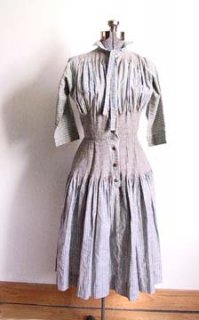
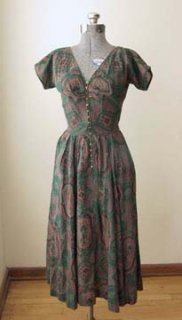
 The ties are attached at the shoulders and just hang down, so can be worn crossed over the bodice (as she has done) and tied in front or back. Since Ms. McCardell prided herself in "easy to wear" dresses, perhaps this was ment to go from day to evening as I show it... could be worn with a rhinestone belt for even fancier look! Has the classic McCardell brass hook at the neck. Stitched down pleated skirt. Measures: 36" bust, up to 28" waist, 30" long from waist to hem, 18" long from shoulder to waist (long-waisted). Excellent condition... with only a sticky metal zipper at side.
The ties are attached at the shoulders and just hang down, so can be worn crossed over the bodice (as she has done) and tied in front or back. Since Ms. McCardell prided herself in "easy to wear" dresses, perhaps this was ment to go from day to evening as I show it... could be worn with a rhinestone belt for even fancier look! Has the classic McCardell brass hook at the neck. Stitched down pleated skirt. Measures: 36" bust, up to 28" waist, 30" long from waist to hem, 18" long from shoulder to waist (long-waisted). Excellent condition... with only a sticky metal zipper at side.